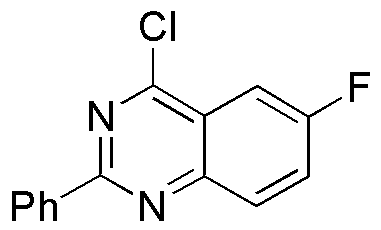4-Chloro-6-fluoro-2-phenyl-quinazoline is widely utilized in research focused on:
- Pharmaceutical Development: This compound serves as a key intermediate in synthesizing various pharmaceuticals, particularly in developing targeted cancer therapies due to its ability to inhibit specific kinases.
- Biological Research: Researchers use it to study cellular signaling pathways, helping to understand disease mechanisms and identify potential drug targets.
- Agricultural Chemistry: It is explored for its potential as a pesticide or herbicide, offering a new approach to pest management in sustainable agriculture.
- Material Science: The compound is investigated for its properties in developing advanced materials, such as organic semiconductors, which can be used in electronic devices.
- Analytical Chemistry: It is employed in various analytical techniques, aiding in the detection and quantification of other chemical substances in complex mixtures.
General Information
Properties
Safety and Regulations
Applications
4-Chloro-6-fluoro-2-phenyl-quinazoline is widely utilized in research focused on:
- Pharmaceutical Development: This compound serves as a key intermediate in synthesizing various pharmaceuticals, particularly in developing targeted cancer therapies due to its ability to inhibit specific kinases.
- Biological Research: Researchers use it to study cellular signaling pathways, helping to understand disease mechanisms and identify potential drug targets.
- Agricultural Chemistry: It is explored for its potential as a pesticide or herbicide, offering a new approach to pest management in sustainable agriculture.
- Material Science: The compound is investigated for its properties in developing advanced materials, such as organic semiconductors, which can be used in electronic devices.
- Analytical Chemistry: It is employed in various analytical techniques, aiding in the detection and quantification of other chemical substances in complex mixtures.
Documents
Safety Data Sheets (SDS)
The SDS provides comprehensive safety information on handling, storage, and disposal of the product.
Product Specification (PS)
The PS provides a comprehensive breakdown of the product’s properties, including chemical composition, physical state, purity, and storage requirements. It also details acceptable quality ranges and the product's intended applications.
Certificates of Analysis (COA)
Search for Certificates of Analysis (COA) by entering the products Lot Number. Lot and Batch Numbers can be found on a product’s label following the words ‘Lot’ or ‘Batch’.
*Catalog Number
*Lot Number
Certificates Of Origin (COO)
This COO confirms the country where the product was manufactured, and also details the materials and components used in it and whether it is derived from natural, synthetic, or other specific sources. This certificate may be required for customs, trade, and regulatory compliance.
*Catalog Number
*Lot Number
Safety Data Sheets (SDS)
The SDS provides comprehensive safety information on handling, storage, and disposal of the product.
DownloadProduct Specification (PS)
The PS provides a comprehensive breakdown of the product’s properties, including chemical composition, physical state, purity, and storage requirements. It also details acceptable quality ranges and the product's intended applications.
DownloadCertificates of Analysis (COA)
Search for Certificates of Analysis (COA) by entering the products Lot Number. Lot and Batch Numbers can be found on a product’s label following the words ‘Lot’ or ‘Batch’.
*Catalog Number
*Lot Number
Certificates Of Origin (COO)
This COO confirms the country where the product was manufactured, and also details the materials and components used in it and whether it is derived from natural, synthetic, or other specific sources. This certificate may be required for customs, trade, and regulatory compliance.


